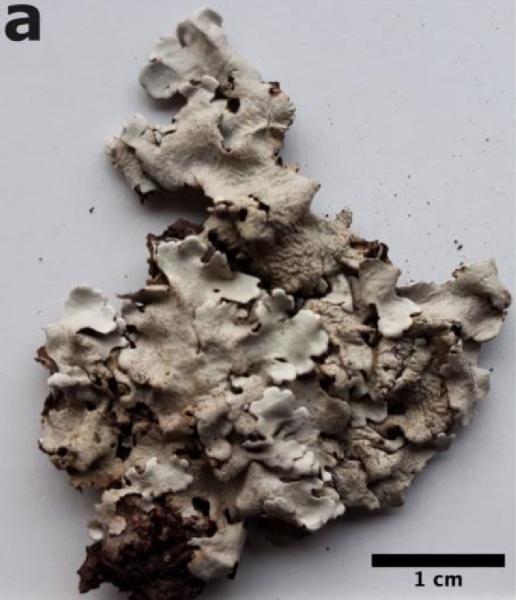Parmelina clandestina Barcenas-Peña, Divakar, A. Crespo, Núñez-Zapata, Lumbsch & Grewe
J. of Fungi, 9, 12, no. 1180: 8, 2023.
Synonyms:
Distribution: N - Frl (Barcenas-Peña & al. 2023). C - Tosc (Barcenas-Peña & al. 2023).
Description: Thallus foliose, heteromerous, forming regular rosettes. Lobes pale mineral grey to blue-grey, more or less shiny, usually pruinose, rounded at apices, smooth, faintly maculate, 2-7 mm wide, with undulate to incised margins and characteristically rounded, eciliate axils, the central parts of thallus with a dense cover of cylindrical, frequently branched, 0.5-1.5 mm tall isidia, concolorous with thallus in lower part, brown to black at tips; lower surface brown at margin, otherwise black, with black, mostly simple, 1-2 mm long rhizines. Upper cortex of tightly packed, anticlinally oriented hyphae, with a pored epicortex, the cell walls with isolichenan; medulla white; algal layer continuous; lower cortex paraplectenchymatous, with rounded and thick-walled cells. Apothecia very rare, lecanorine, up to 4 mm across, with a brown disc and a usually isidiate thalline margin. Epithecium brownish; hymenium and hypothecium colourless. Asci 8-spored, Lecanora-type. Ascospores 1-celled, hyaline, short-ellipsoid, 9-13 x 5-7 μm. Pycnidia rare, appearing as black dots. Photobiont chlorococcoid. Spot tests: upper cortex K+ yellow, C-, KC-, P-; medulla K-, C+ red, KC+ red, P- or P+ faintly yellow, UV-. Chemistry: upper cortex with atranorin, medulla with lecanoric acid.Note: a cryptic epiphytic species, which can be distinguished from the sympatric P. tiliacea only by genome data of single-nucleotide polymorphisms (SNPs) produced by RAD sequencing, hitherto known from Germany, Italy, Morocco, Portugal, Slovenia, Spain, Turkey, and the UK. For further details see Barcenas-Peña & al. (2023).
Growth form: Foliose, broad lobed
Substrata: bark
Photobiont: green algae other than Trentepohlia
Reproductive strategy: mainly asexual, by isidia, or isidia-like structures (e.g. schizidia)
Poorly known taxon in need of further study
Commonnes-rarity: (info)
Alpine belt: absent
Subalpine belt: absent
Oromediterranean belt: absent
Montane belt: very rare
Submediterranean belt: very rare
Padanian area: absent
Humid submediterranean belt: very rare
Humid mediterranean belt: absent
Dry mediterranean belt: absent

Predictive model

Source: Barcenas-Peña A., Divakar P.K., Crespo A., Núñez-Zapata J., Lumbsch H.T., Grewe F. 2023. Reference-based restriction-site-associated DNA sequencing data are useful for species delineation in a recently diverged asexually reproducing species complex (Parmeliaceae, Ascomycota). J. of Fungi, 9, 12:1180.
holotype
Growth form: Foliose, broad lobed
Substrata: bark
Photobiont: green algae other than Trentepohlia
Reproductive strategy: mainly asexual, by isidia, or isidia-like structures (e.g. schizidia)
Poorly known taxon in need of further study
Commonnes-rarity: (info)
Alpine belt: absent
Subalpine belt: absent
Oromediterranean belt: absent
Montane belt: very rare
Submediterranean belt: very rare
Padanian area: absent
Humid submediterranean belt: very rare
Humid mediterranean belt: absent
Dry mediterranean belt: absent

Predictive model


